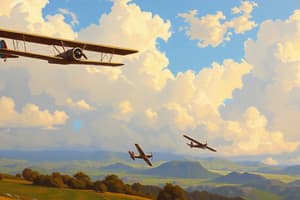Podcast
Questions and Answers
What term is used to describe vibrations created by wind shear forces over the wing of an aircraft?
What term is used to describe vibrations created by wind shear forces over the wing of an aircraft?
- Turbulence
- Lift
- Drag
- Flutter (correct)
What can occur due to flutters in aircraft wings?
What can occur due to flutters in aircraft wings?
- Earthquakes
- Standing waves (correct)
- Tornadoes
- Rainbows
What is the main implication of standing waves or pressure fluctuations in an aircraft's wings?
What is the main implication of standing waves or pressure fluctuations in an aircraft's wings?
- Higher passenger capacity
- Increased fuel efficiency
- Enhanced speed
- Aerodynamic instability (correct)
What can happen if flutter is not mitigated through proper design measures?
What can happen if flutter is not mitigated through proper design measures?
What causes flutter to amplify initial wind disturbances in aircraft wings?
What causes flutter to amplify initial wind disturbances in aircraft wings?
When does flutter usually occur in aircraft wings?
When does flutter usually occur in aircraft wings?
What impact can high frequency flutter vibrations have on an aircraft's wing surface?
What impact can high frequency flutter vibrations have on an aircraft's wing surface?
How can flutter vibrations affect an aircraft's lift coefficient?
How can flutter vibrations affect an aircraft's lift coefficient?
What is one method used to prevent flutter in aircraft design?
What is one method used to prevent flutter in aircraft design?
How can active control systems help prevent flutter?
How can active control systems help prevent flutter?
What structural consideration can influence the likelihood of flutter in an aircraft?
What structural consideration can influence the likelihood of flutter in an aircraft?
Why is it important for engineers to carefully design the flexibility of each section of an aircraft's wing?
Why is it important for engineers to carefully design the flexibility of each section of an aircraft's wing?
Flashcards are hidden until you start studying
Study Notes
Flutter is the term used to describe vibrations created by wind shear forces over the wing of an aircraft. Standing waves, also known as pressure fluctuations, can occur due to these flutters and have significant implications for the structural integrity and aerodynamic performance of the aircraft's wings. This phenomenon has been studied extensively, leading to various findings that help aviation engineers design more stable aircraft and identify potential issues before they become critical.
Understanding Flutter
Flutter refers to the instability caused by vortices induced by wing motion in response to wind gusts. These vortices change the airflow around the wing, creating a feedback loop where the wing movement changes the flowfield, which in turn causes further wing oscillations. This cycle continues, amplifying the initial wind disturbance until it reaches a point where the aircraft is unable to sustain flight.
Flutter usually occurs when the frequency of the wing oscillations matches the natural frequency of the structure, resulting in resonant behavior. This condition can lead to destructive structural damage if not mitigated through proper design measures.
Effects of Flutter
The effects of flutter are evident in various aspects of an aircraft's aerodynamics and mechanical dynamics. Some key impacts include:
- Wing Vibration: The high frequency flutter vibrations can cause large amplitude motion in the wing surface, potentially causing fatigue damage or even catastrophic failure.
- Aerodynamic Performance: Flutter vibrations can significantly affect the aircraft's lift coefficient, causing a drop in thrust efficiency and increased drag during climb and descent phases.
- Noise Generation: The rapid airflow variations associated with flutter can generate noise, affecting both pilot comfort and ground operations.
Mitigating Flutter
To prevent flutter from occurring, several strategies are employed in aircraft design. These include:
- Designing Flexibility into Wings: By carefully designing how much flexibility each section of the wing allows, engineers can ensure that the wing will respond appropriately to wind conditions without triggering damaging flutter.
- Controlling Wing Motion: Active control systems can detect signs of impending flutter and adjust aircraft parameters to prevent it. These systems may use sensors to monitor wing flexion and aileron angle, or may incorporate autopilot software with specific algorithms designed to detect and counteract flutter.
- Additional Structural Considerations: Material choices, such as the thickness of wing skins and the arrangement of ribs, can influence the likelihood of flutter. Additionally, some designs may feature improvements like spanwise torsional restraint devices, which limit relative motion between sections of the wing.
By employing these methods, designers can create aircraft that are resistant to flutter, ensuring their safety and stability under a wide range of conditions.
Studying That Suits You
Use AI to generate personalized quizzes and flashcards to suit your learning preferences.




